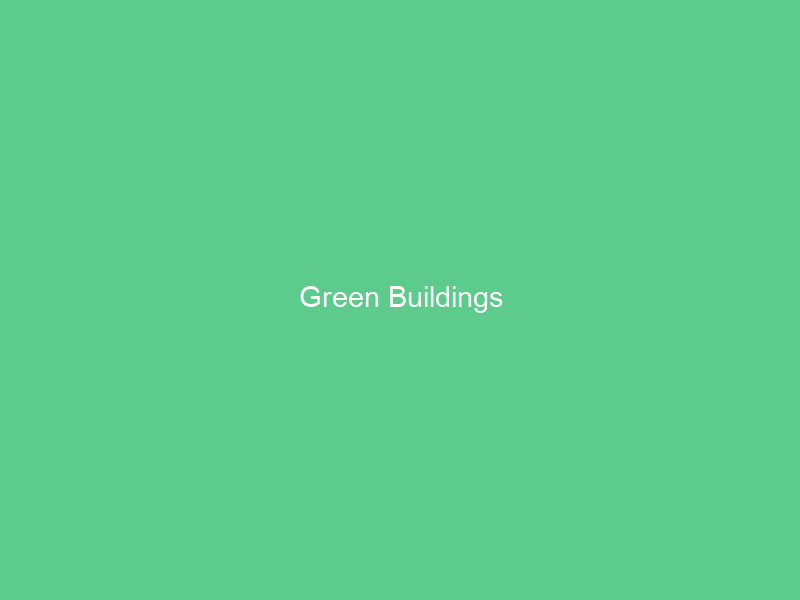Green buildings reduce carbon emissions and reuse materials while supporting local business and creating a diverse economy. Furthermore, green buildings improve indoor air quality which contributes to healthier, more productive lives for their occupants.
Green buildings utilize eco-friendly construction techniques that exceed current building codes, while also taking advantage of energy efficient appliances, renewable energy sources, and solar water heating technology.
Energy Efficiency
Green buildings use less energy, thereby minimizing their environmental impacts both directly and indirectly. LEED (Leadership in Energy and Environmental Design), British BREEAM and Germany’s DGNB systems are used as certification standards to evaluate green buildings. These ratings consider all environmental, social and economic consequences associated with building projects through life cycle assessments.
Energy optimization strategies involve improving insulation, HVAC and lighting systems efficiency and the integration of renewable energy sources to decrease fossil fuel dependence. Energy efficiency also has indirect benefits, including reduced air pollutants that contribute to cardiovascular diseases and asthma; optimizing indoor environments can positively influence health by offering access to natural sunlight that boosts mood-lifting effects as well as healthy ventilation solutions.
Water Conservation
Green technologies in buildings can dramatically enhance their sustainability, both by cutting energy use in extracting, processing, transporting and operating building materials as well as for heating, lighting and powering equipment.
Water conservation in green buildings also relies on using low-flow plumbing fixtures, collecting rainwater for use in irrigation, grey water systems and non-potable uses (LEED). Installing toilets that conserve water by not losing excess through waste can save a substantial amount, while landscaping with native or drought-tolerant plants reduces irrigation needs significantly.
Green buildings can help ease strain on both local and global water supply systems by saving freshwater for future generations to use. Through this practice, it ensures freshwater remains available.
Indoor Air Quality
Green buildings prioritize indoor air quality by bringing fresh outside air in through doors and vents, eliminating sources of pollutants, and using materials with lower VOC emissions. They also minimize artificial lighting use in favor of natural daylight sources.
Studies indicate that tenants in green buildings report fewer health issues, such as fatigue and headaches, than those living in traditional structures. They also demonstrate superior cognitive performance and enhanced concentration levels.
Poor indoor air can lead to respiratory illnesses, allergies and increased stress levels – with long-term exposure leading to cancer or other serious illnesses. Furthermore, exposure can contribute to general feelings of malaise known as Sick Building Syndrome (SBS), often seen in buildings constructed prior to 1990. Green buildings provide healthier air, helping mitigate potential SBS symptoms.
Materials
Climate change has thrust green buildings to the forefront of industry discussion. Such buildings use sustainable materials that decrease their environmental footprint while providing healthier and more comfortable spaces for their occupants.
Many eco-builders opt for products harvested locally, grown sustainably or recycled materials in order to promote a strong local economy and reduce transportation costs while simultaneously cutting energy consumption and emissions.
Innovative green materials include biodegradable plastics, concrete that uses bacteria to grow and repair itself, wood logs that store carbon while living, low-VOC paints with minimal chemical emissions used in green buildings to avoid formaldehyde emissions that cause health problems in indoor air, low-VOC paints used as building material, etc.
Sustainability
Green buildings are an essential element of sustainable urban development that works towards combatting climate change. By reducing energy consumption and emissions, they help lower CO2 levels in the atmosphere.
Green building practices seek to minimize environmental impact throughout a building’s lifecycle by applying careful design, construction, occupancy, renovation and demolition practices. Green buildings go beyond minimum building codes by offering features like recycling materials during renovation, embedded energy efficiency measures such as solar water heating systems or low-flow toilets that go above and beyond minimum requirements.
Sustainable building practices focus on mitigating risks from natural disasters by employing site selection strategies, flood and wildfire mitigation tactics and passive survivability techniques. In addition, sustainable building practices aim to enhance occupant health through optimised indoor environments which improve productivity and quality of life – such as decreasing absenteeism due to asthma, respiratory allergies and depression as well as self-reported reductions in stress levels.

